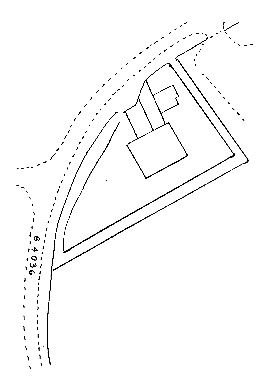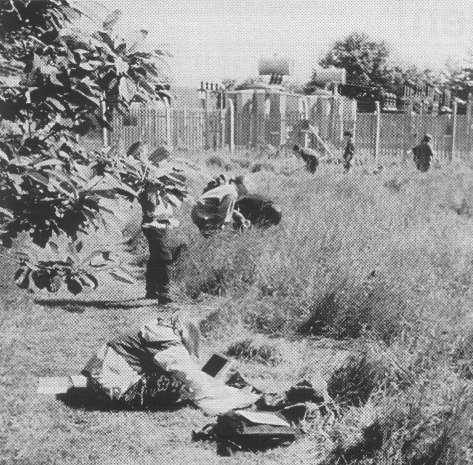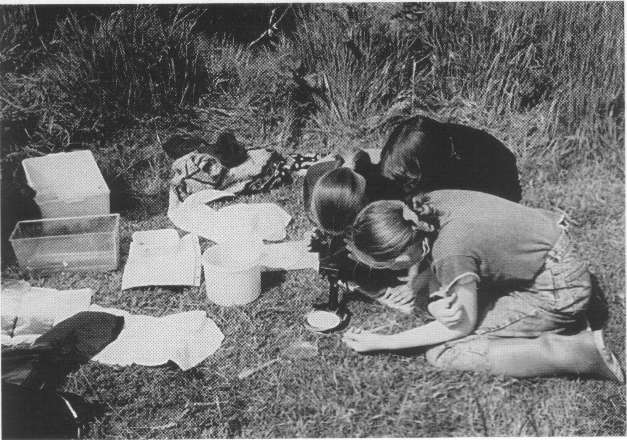All creatures great and small on a database
Bob Cotter
Headteacher, Welton CE Primary School, Daventry Northants
This article first appeared in MicroScope Environmental Special Spring 1998
 Welton CE Primary school lies in the rolling countryside to west of
Northampton and just north of Daventry, home of the once famous BBC masts. The village
school has 110 pupils and just four full-time teachers including the head. The school has
developed its work in IT over the past few years and this has been greatly helped by an
influx of portable computers in 1993. The work of the school often stretches out into the
local area and when it was asked to be involved in the establishment and development of a
'pocket park', a local community conservation scheme run by the Northamptonshire County
Council, the chance to be involved was quickly seized by the school. Welton CE Primary school lies in the rolling countryside to west of
Northampton and just north of Daventry, home of the once famous BBC masts. The village
school has 110 pupils and just four full-time teachers including the head. The school has
developed its work in IT over the past few years and this has been greatly helped by an
influx of portable computers in 1993. The work of the school often stretches out into the
local area and when it was asked to be involved in the establishment and development of a
'pocket park', a local community conservation scheme run by the Northamptonshire County
Council, the chance to be involved was quickly seized by the school.
One area where the school saw a value to both the 'park' and pupils was in monitoring
the wildlife that visited the park. The park is situated about 2 miles outside the
village, right near another of Northamptonshire's famous landmarks, the Watford Gap
Service Station on the Ml motorway. The park is situated on land that surrounds an
electricity substation and was donated to Welton Parish Council by East Midlands
Electricity. The site has an area of approximately one acre and initially contained areas
of established woodland and meadow. As it was an area in a potentially dangerous location,
the general public were neither inclined, nor encouraged, to visit the site, and as a
result it became a haven for wildlife which enjoyed the relative security of a
'people-free' zone. In fact it was area ripe for study for anyone, let alone a school. It
was an opportunity we did not wish to pass up.
Once the park was formally handed over to the parish in 1993 and officially opened in
the September of that year, the School moved in to monitor the wildlife. We were not
aware, until we started to collect information, that such a rich area for study was at our
disposal. The children's first examination of the park revealed just trees and grass and
on the surface it looked relatively uninteresting. Within a short space of time and
through regular visits during the early months of our work, we uncovered a wide variety of
evidence relating to the animals that regularly visited the park. During the Spring of
1994, we built a sizeable pond, with help from a local farmer and the local fire brigade.
The fire brigade found it particularly useful for trying out their new water tender and
kindly filled up the hole! This completed the three key types of habitat, adding water to
the existing woodland and meadow. The addition of the pond provided a superb area for pond
life studies and each creature found is dutifully recorded and logged on the database.
Other areas of the curriculum came in too... the making and siting of bird and bat boxes
has provided an element of technology… and the opportunity to be involved in tree and
hedge planting gave us lessons in science and conservation. There is still much to be done
and no doubt the work could continue well into the next millennium.
The children were warned that they were unlikely to see many animals in the flesh, so
they were encouraged to look for the 'evidence' to help them identify the creatures that
visited the park. A whole range of work grew around this project, putting into real use
the work they had done on 'the variety of life and living processes'. The need to store
the information was obvious and the use of a database seemed the most logical means of
doing this. Having a good supply of portables meant that the computers could be taken to
the site and the data recorded at the park. This took away the need for countless sheets
of paper and clipboards, the bane of most fieldwork. During the early months of the
project, a common sight was a 'snake' of year 5/6 children, weighed down by
identification charts and books and notebook computers, winding its way through the local
countryside en-route to the pocket park. During the course of that year many children
seemed to grow longer arms as the weight of the computers taxed their strength! Somehow
the return journey always seemed more arduous, whether it was the weight of the extra data
stored in the computer, we shall never know, but slowly the amount of information in the
database became more and more substantial. There were times when we longed to trade our
high grade Research Machines NB300 A4 notebooks into smaller palmtops or even 'pocket
book' computers.
 The children used a database called Clipboard, produced by
Black Cat Software and stored on the hard disk in the RM 'Window Box' system. The database
is flexible and very good for storing the sort of information we needed, offering both
numerical and text data, along with a useful facility using 'keywords' to select the
appropriate wording for the data entry. The children used a database called Clipboard, produced by
Black Cat Software and stored on the hard disk in the RM 'Window Box' system. The database
is flexible and very good for storing the sort of information we needed, offering both
numerical and text data, along with a useful facility using 'keywords' to select the
appropriate wording for the data entry.
The children worked collaboratively to construct their own fields in the database and a
lot of preparatory work was carried out in classifying, sorting and analysing the type of
information we needed to set up the database. Once this was done we started to collect the
data. Three years later we are still collecting and have now added a variety of different
wildlife to the database. Early information collected saw evidence of foxes, badgers,
stoats, weasels, woodmice, grass snakes, rabbits, hares and, of course numerous birds.
Little owl pellets were found and examined and the contents gave us further evidence of
the likely creatures in the area. The skeletal remains of weasels and stoats were
fascinating to the children and their uncovering was reminiscent of an archaeological dig
rather than an environmental project. The children became experts at examining droppings
(and their contents!), looking for teeth marks on nut kernels and spotting tracks and
footprints. Each identified animal was recorded and the relevant details noted on the
database. Details of the evidence were also noted and as the types of evidence changed,
the database fields were extended. The occasional tramp enjoyed a visit too and we often
found evidence of his visits!
The winter proved a very good time for this type of work as tracks and signs were easy
to find. Even the fur of some hapless rabbit or the half eaten remains of a bird, gave us
vital clues as to the activity in the park when no-one was around. The rare sighting of a
live mammal was a highlight (with the exception of rabbits, which seemed oblivious to the
presence of children), but this was occasionally tempered by the sighting of a dead animal
on the adjacent road. The children were saddened when they found a dead fox one winter's
morning. The frosted remains, a fresh meal for carrion birds, lay in the gutter, having
been struck a fatal blow by a passing car. The fox had clearly visited our park on his
travels that night and would leave us no further evidence. However, I am pleased to say
other foxes have chosen to visit the park and one chose it as a final resting place; his
corpse is slowly rotting to provide the children with another 'gem' to find when we next
visit. One wonders if he had an inkling that he would add to the richness of the pocket
park.
By the time summer comes round the park is lush with growth and evidence of finding
larger mammals is scarce. The insects and birds take over and the project takes on a whole
new dimension. Dragonflies now dart across the pond and lay their eggs in the water.
Damselflies do likewise while their young terrorise the invertebrate life that quickly
colonised the pond. The meadows are thick with a myriad of insect life of all kinds.
Scorpion flies, frog-hoppers, shield bugs, worms and molluscs all form part of nature's
food chain and ever-new areas for study for the children. The speckled wood butterfly is a
common visitor and during the late summer they are in abundance. Frogs are now common and
the occasional newt has been uncovered, hiding under a stone. Evening visits are often out
of the question, but pipistrelle bats use the twilight to catch the insects for their
evening meal.
Now we only take two or three computers and the information is recorded by groups and
shared back at the school. The data is analysed, the habits and habitats of the creatures
are written up, and the information presented in written reports, graphs and charts. As
each season passes, the work is recorded and the visits are always eagerly anticipated by
the children. Some children take their parents at weekends and often will note any
creatures they find when they come back to school.
As the store of information steadily increases and the children change year groups, the
work remains interesting because children, as always, remain fascinated by wildlife. The
need to use this store of information is a future project and although the data will
continue to be collected, the opportunities are arising for putting together the findings
into the information leaflets for the general public. Thoughts of a CD-ROM package for the
rest of the school to share are also going through the mind. The latter idea offers a very
attractive development and could prove a very worthwhile task once the work can be
transferred onto an 'authoring' package.

The whole thing sounds very idyllic and it seems plain sailing. It has been hard work
and the evidence is occasionally thin on the ground. The national curriculum requirements
can impinge on the work and other work has to take a priority in the busy schedule of the
school. Software can sometimes let you down and portables have a habit of running out of
power just when you do not have an opportunity to recharge them, even if you do have a
high voltage electricity sub station within easy reach - connecting them up seems a little
risky! The portables are not always easy to see in the open, especially when the sun
shines brightly - and where do you keep the mouse? Then there was the time one summer when
we opened the computers up at school and various insects crawled from under the keys. It
put a new meaning into getting bugs in the computer. My service engineer can never work
out how we need grass cleaning out of the computer casings when he services them and I
dread to think what else he discovers! One thing can be sure, it leads to an interesting
time and work, even on a computer database, is never dull.
Finally, our pocket park database is an on-going resource and many children contribute
to it as terms roll by. You may think we are lucky to have such a resource and perhaps we
are. Most schools have access to areas where wildlife is in evidence, however, you cannot
always see it and you need to look carefully. You can even adapt an environment and
attract the creatures to you. Build a pond, put in plants that attract butterflies and
other insects, set up woodpiles and compost heaps and you'll be surprised what will come
to you. What we are creating, and you can do it too, is a store of information that is fun
to collect, has a relevant purpose and will be available to pupils in your school, as
future resource for years to come. Go on, try it!
[top of page]
|

